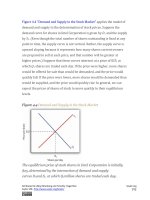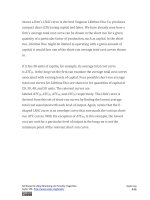Authors libby rittenberg 195
Bạn đang xem bản rút gọn của tài liệu. Xem và tải ngay bản đầy đủ của tài liệu tại đây (416 KB, 1 trang )
If financial investors decide that a company is likely to be more
profitable, then the supply of the stock shifts to the left (in this case,
from S1 to S2), and the demand for the stock shifts to the right (in this
case, from D1 toD2), resulting in an increase in price fromP1 to P2.
Other factors may alter the price of an individual corporation’s share of
stock or the level of stock prices in general. For example, demographic
change and rising incomes have affected the demand for stocks in recent
years. For example, with a large proportion of the U.S. population nearing
retirement age and beginning to think about and plan for their lives during
retirement, the demand for stocks has risen.
Information on the economy as a whole is also likely to affect stock prices.
If the economy overall is doing well and people expect that to continue,
they may become more optimistic about how profitable companies will be
in general, and thus the prices of stocks will rise. Conversely, expectations
of a sluggish economy, as happened in the fall of 2008, could cause stock
prices in general to fall.
The stock market is bombarded with new information every minute of
every day. Firms announce their profits of the previous quarter. They
announce that they plan to move into a new product line or sell their goods
in another country. We learn that the price of Company A’s good, which is a
substitute for one sold by Company B, has risen. We learn that countries
sign trade agreements, launch wars, or make peace. All of this information
may affect stock prices because any information can affect how buyers and
sellers value companies.
KEY TAKEAWAYS
Attributed to Libby Rittenberg and Timothy Tregarthen
Saylor URL: />
Saylor.org
195









